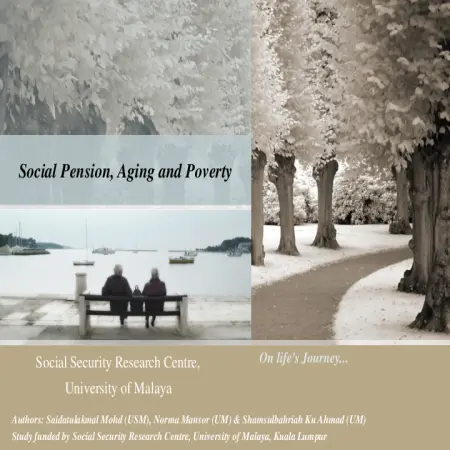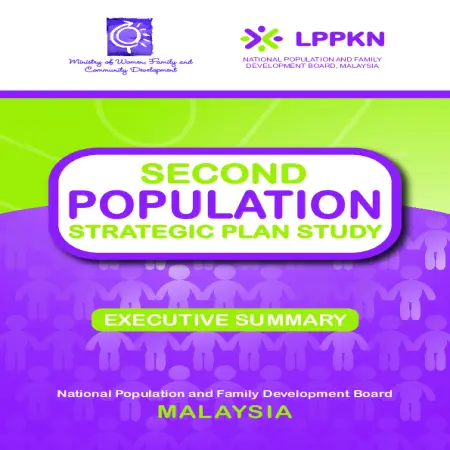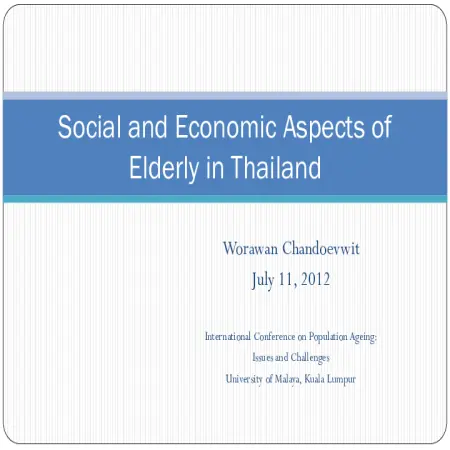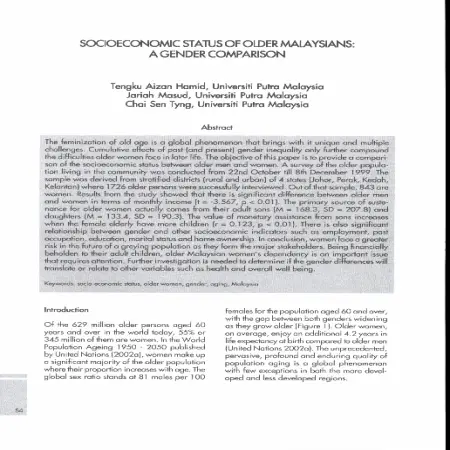Browse by Subject
Results for Search : "303 Social processes"
|
|
Social pension, aging and poverty in Malaysia
Item Type: Conference or Workshop Item
Editor:
Year: 00/00/2014
Abstract: The increasing number of elderly in Malaysia calls for a more stringent policy to safeguard the well-being of the elderly. The old age protection such as the pension scheme, Employees Provident Fund and the old age cash assistance although in tact, deemed to be inadequate to eradicate elderly poverty. One possible solution to secure financial protection during old age is through social pension that provides non-labor income for the retirees or elderly with the purpose of preventing or reducing elderly poverty. This paper attempts to estimate the financial cost of social pension scheme and quantify its potential role in reducing elderly poverty in Malaysia. The financial cost of social pension scheme was calculated as a percentage to GDP. By using the 2009 household income expenditure survey, the paper estimated the potential roles of social pension in eradicating elderly poverty. Sensitivity analysis indicated that the cost social pension could be kept at an average of 1.30 percentage of GDP. The 2009 HIES data also indicated that poverty could be eventually be eradicated with social pension while cost of the social pension was kept at reasonable levels.
|
|
|
|
|
|
Socio-economic determinants of pap smear screening among married women in Peninsular Malaysia
Item Type: Article
Editor:
Year: 00/02/2013
Abstract: This study is to identify the influences of socio-economic factors towards the practice of Pap smear screening among ever married women. Bivariate correlations and logistic regression analysis was applied to the data set containing 3,283 ever married women age 15-49 years, interviewed during the Fourth Malaysian Population and Family Survey, 2004. It was found that only half the women had undergone Pap smear screening prior three years of survey, in which Chinese had the highest percentage of Pap smear screening. The logistic statistical analysis also had identified several variables has important determinant has of Pap smear screening for ever married women. Finding from this study suggest a significant relationship between the cervical cancer awareness and knowledge, age and ethnicity for those women who practice Pap smear screening.
|
|
|
|
|
|
Second Population Strategic Plan Study : Executive Summary
Item Type: Book
Editor:
Year: 00/09/2012
Abstract: The Second Population Strategic Plan Study was conducted from July 2008 – December 2009 by the Ministry of Women, Family and Community Development through the National Population and Family Development Board. This study is a follow-up to the 1st Population Strategic Plan Study conducted in 1992. The objectives of the Second Population Strategic Plan Study are to assess and evaluate the implementation of the national population programme in the context of current policies; and to recommend a strategic plan of action framework for the implementation of future population and development programmes.
|
|
|
|
|
|
Social and economic aspects of elderly in Thailand
Item Type: Conference or Workshop Item
Editor:
Year: 00/00/2012
Abstract: Thailand is already an aging society. About 14% of population are elderly. Using a national survey, it can be shown that 16% of elderly households in the rural area have substandard living condition. The majority of elderly (60%) rely on remittance for their living. About 20% of elderly have to work for living and only 4% have government pension. Thailand is now organizing a National Saving Fund to promote saving for retirement. Another national survey finds that 80% of population want to save for their retirement but only 48% think that they can make regular monthly saving. This is consistent with another survey which finds that 50%-60% of elderly actually prepared themselves physically and mentally into the elder period. Elderly are less happy than the young. They are quite healthy, about 90% of those in the 65-74 age group can take care of themselves. It was quite normal in the Thai culture that children take care of their old parents. Above 80% of population expect that their children will take care of them physically, mentally, and financially when they become old. Taking care of old parents is something done by daughter. About 45% of elderly who are older than 94 years are taken care by daughter or daughter-in-law, another 38% take care of themselves. UN projects that Thailand will have 20 million elderly in the next 20 years which makes the elderly account for 26% of population or 45% of working age population. Without income security and long term care schemes for elderly, it would be very difficult for children to take care of their parents.
|
|
|
|
|
|
Socio-economic correlates of fertility in Peninsular Malaysia
Item Type: Thesis
Editor:
Year: 01/04/2009
Abstract: The main aim of this paper is to examine the fertility trends and differentials among Peninsular Malaysia women based on the 2004 Malaysian Population and Family Survey (MPFS-4) according to selected socio-economic variables which were found to have significant effect on number of children ever born. Findings from the study reveal that mean number of children ever born has dropped from 4.2 children in 1974 to 3.6 children in 1984, 3.4 children in 1994 and continued to decline to 3.1 in 2004. Fertility level is highest among Malays, who resides in rural areas, eastern region, lower educational level, women who had never worked, women whose husbands worked in agricultural sector and family income less than RM1000 a month. Socio-economic variables can only affect the fertility level through the intermediate variables such as postponement of marriage and use of contraception. There is an upward trend in age at first marriage from 17.6 years in 1974 to 22.0 years in 2004. Marriage postponement is more pronounced among highly educated Chinese women, followed by the Indians and the Malays. The contraceptive prevalence rate was highest among Chinese, followed by the Indians and the Malays. Ethnic differentials in number of children ever born are rather pronounced. In the multivariate context, after adjusting for age and age at first marriage, the differential in the mean number of children ever born among ethnic groups remain discernible. The socio¬economic variables have different effects on the fertility level of each ethnic group. 'Region' emerges as the most important predictor of Malay fertility, while 'work pattern' and 'family income' is the most important predictor of Chinese and Indian fertility respectively. Based on the present trend, it is highly likely that the fertility will reach replacement level by 2020, and the 70 million population target is unlikely to be achieved through natural increase. There is a need for the government to give some attention to the trend in delayed and non-marriage as this will determine to a large extent the future course of population growth in Malaysia.
|
|
|
|
|
|
Socioeconomic status of older Malaysians: a gender comparison
Item Type: Article
Editor:
Year: 00/01/2004
Abstract: The feminization of old age is a global phenomenon that brings with it unique and multiple challenges. Cumulative effects of past (and present) gender inequality only further compound the difficulties older women face in later life.The objective of this paper is to provide a comparison of the socioeconomic status between older men and women. A survey of the older population living in the community was conducted from 22nd October till 8th December 1999.The sample was derived from stratified district (rural and urban) of 4 states (Johor, Perak, Kedah, Kelantan) where 1726 older persons were successfully interviewed. Out of that sample, 843 are women. Results from the study showed that there is significant difference between older men and women in terms of monthly income(t=-3.567,p<0.01). The primary source of sustenance for older women actually comes from their adults sons (M=168.3, SD=207.8)and daughters (M=133.4,SD=190.3). The value of monetary assistance from sons increases when the female elderly have more children (r=0.123,p<0.01). There is also significant relationship between gender and other socioeconomic indicators such as employment, past occupation, education, marital status and home ownership. In conclusion, women face a greater risk in the future of a greying population as they form the major stakeholders. Being financially beholden to their adult children, older Malaysian women's dependency is an important issue that requires attention. Further investigation is needed to determine if the gender differences will translate or relate to other variables such as health and overall well being.
|
|
|
|
|
|
Study on migration: study of four major cities in Peninsular Malaysia
Item Type: Research Report
Editor:
Year: 00/00/1979
Abstract: This study aims at providing some information about the origin of the migrants in terms of place of birth and previous residence and reason for making the moves. The problem of excessive population growth rate in the metropolitan areas of less developed countries has been a major area of concern. In Peninsular Malaysia, the average annual population growth rate in urban areas during the 1970-1980 period was 4.7 per cent while in the rural areas it was only 0.9 per cent. This difference was due not only to differences in rates of natural increase but mainly because of internal migration. Such trends in migration will have significant demographic and socio-economic effects on both the rural and urban areas. Studies on internal migration in Malaysia have focus primarily on the analysis of levels and trends, using data available from population census. Information obtained from such data are rather limited and thus sample surveys have been conducted to gather detailed information regarding reasons for migration, migrants characteristics, migration related decision-making process and post-migration adaptation.
|
|
|
|











